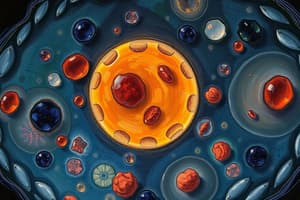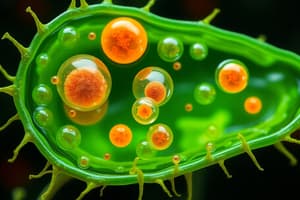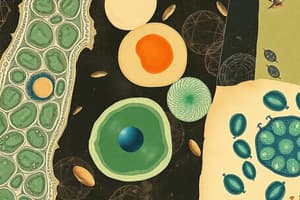Podcast
Questions and Answers
What is the control center of a cell?
What is the control center of a cell?
Nucleus
Which organelle produces energy?
Which organelle produces energy?
Mitochondria
What is the function of ribosomes?
What is the function of ribosomes?
Protein synthesis
Which organelle packages and transports proteins?
Which organelle packages and transports proteins?
What part of the plant cell supports its structure?
What part of the plant cell supports its structure?
What is the jelly-like substance inside cells?
What is the jelly-like substance inside cells?
Animal cells have chloroplasts.
Animal cells have chloroplasts.
What is the function of the vacuole in plant cells?
What is the function of the vacuole in plant cells?
How do materials enter and exit the cell?
How do materials enter and exit the cell?
What do lysosomes do?
What do lysosomes do?
Name one structure found in plant cells but not animal cells.
Name one structure found in plant cells but not animal cells.
Which cell type has a larger vacuole, plant or animal?
Which cell type has a larger vacuole, plant or animal?
What is the purpose of chloroplasts?
What is the purpose of chloroplasts?
Do both plant and animal cells have mitochondria?
Do both plant and animal cells have mitochondria?
Which organelle is responsible for making proteins?
Which organelle is responsible for making proteins?
The nucleus is present in all cells.
The nucleus is present in all cells.
What is the function of the endoplasmic reticulum?
What is the function of the endoplasmic reticulum?
What do centrioles help with in animal cells?
What do centrioles help with in animal cells?
All cells have a plasma membrane.
All cells have a plasma membrane.
Which part of the plant cell absorbs sunlight?
Which part of the plant cell absorbs sunlight?
What is the function of the digestive system?
What is the function of the digestive system?
Where does digestion begin?
Where does digestion begin?
Which organ produces bile?
Which organ produces bile?
Where is bile stored?
Where is bile stored?
What enzyme breaks down starch?
What enzyme breaks down starch?
What organ absorbs nutrients into the bloodstream?
What organ absorbs nutrients into the bloodstream?
The stomach uses mechanical and chemical digestion.
The stomach uses mechanical and chemical digestion.
Which organ removes water from digested food?
Which organ removes water from digested food?
What acid helps digest food in the stomach?
What acid helps digest food in the stomach?
Which organ is responsible for producing insulin?
Which organ is responsible for producing insulin?
What is the main function of the respiratory system?
What is the main function of the respiratory system?
What organ is responsible for breathing?
What organ is responsible for breathing?
What structure prevents food from entering the trachea?
What structure prevents food from entering the trachea?
Where does gas exchange occur in the lungs?
Where does gas exchange occur in the lungs?
Which muscle helps with breathing?
Which muscle helps with breathing?
The trachea leads to the stomach.
The trachea leads to the stomach.
What gas do we inhale?
What gas do we inhale?
What is the purpose of mucus in the respiratory system?
What is the purpose of mucus in the respiratory system?
What part of the body controls breathing rate?
What part of the body controls breathing rate?
What is the function of the circulatory system?
What is the function of the circulatory system?
What is the main organ of the circulatory system?
What is the main organ of the circulatory system?
What vessels carry blood away from the heart?
What vessels carry blood away from the heart?
What vessels carry blood back to the heart?
What vessels carry blood back to the heart?
What vessels allow gas exchange with tissues?
What vessels allow gas exchange with tissues?
Which part of the heart pumps oxygen-rich blood?
Which part of the heart pumps oxygen-rich blood?
What component of blood carries oxygen?
What component of blood carries oxygen?
The circulatory system works with the respiratory system.
The circulatory system works with the respiratory system.
Which blood type is the universal donor?
Which blood type is the universal donor?
What is the liquid part of blood called?
What is the liquid part of blood called?
Flashcards
What is the cell's control center?
What is the cell's control center?
Control center of the cell, contains DNA.
Which organelle produces energy?
Which organelle produces energy?
The powerhouse of the cell, produces energy (ATP).
What does the Golgi apparatus do?
What does the Golgi apparatus do?
Packages and transports proteins within the cell.
What supports plant cell structure?
What supports plant cell structure?
Signup and view all the flashcards
What do lysosomes do?
What do lysosomes do?
Signup and view all the flashcards
What's the main function of the respiratory system?
What's the main function of the respiratory system?
Signup and view all the flashcards
What organ does breathing?
What organ does breathing?
Signup and view all the flashcards
Which muscle helps with breathing?
Which muscle helps with breathing?
Signup and view all the flashcards
What is the purpose of mucus?
What is the purpose of mucus?
Signup and view all the flashcards
What is the function of the circulatory system?
What is the function of the circulatory system?
Signup and view all the flashcards
Study Notes
- The nucleus is the control center of a cell.
- Mitochondria produce energy for the cell.
- Ribosomes are responsible for protein synthesis.
- The Golgi apparatus packages and transports proteins.
- The cell wall supports the structure of plant cells.
- Cytoplasm is the jelly-like substance inside cells.
- Animal cells do not have chloroplasts.
- Vacuoles in plant cells store water and nutrients.
- Materials enter and exit the cell through the cell membrane.
- Lysosomes break down waste and old cell parts.
- Structures found in plant cells but not animal cells include the cell wall, chloroplasts, and large vacuole.
- Plant cells have larger vacuoles than animal cells.
- Chloroplasts are responsible for photosynthesis.
- Both plant and animal cells have mitochondria.
- Ribosomes are responsible for making proteins.
- The nucleus is not present in all cells; prokaryotic cells lack a nucleus.
- Endoplasmic reticulum transports proteins and lipids.
- Centrioles help with cell division in animal cells.
- All cells have a plasma membrane.
- Chloroplasts absorb sunlight in plant cells.
Digestive System
- The digestive system breaks down food for energy.
- Digestion begins in the mouth.
- The liver produces bile.
- Bile is stored in the gallbladder.
- Amylase is the enzyme that breaks down starch.
- The small intestine absorbs nutrients into the bloodstream.
- The stomach uses mechanical and chemical digestion.
- The large intestine removes water from digested food.
- Hydrochloric acid helps digest food in the stomach.
- The pancreas is responsible for producing insulin.
Respiratory System
- The main function of the respiratory system is gas exchange (oxygen in, carbon dioxide out).
- Lungs are responsible for breathing.
- The epiglottis prevents food from entering the trachea.
- Gas exchange occurs in the alveoli of the lungs.
- The diaphragm is the muscle that helps with breathing.
- The trachea leads to the lungs, not the stomach.
- We inhale oxygen.
- We exhale carbon dioxide.
- Mucus in the respiratory system traps dust and pathogens.
- The brainstem/Medulla Oblongata controls breathing rate.
Circulatory System
- The function of the circulatory system is to transport oxygen, nutrients, and waste.
- The heart is the main organ of the circulatory system.
- Arteries carry blood away from the heart.
- Veins carry blood back to the heart.
- Capillaries allow gas exchange with tissues.
- The left ventricle pumps oxygen-rich blood.
- Red blood cells/hemoglobin carry oxygen in the blood.
- The circulatory system works with the respiratory system.
- O- is the universal blood donor.
- Plasma is the liquid part of blood.
Studying That Suits You
Use AI to generate personalized quizzes and flashcards to suit your learning preferences.




